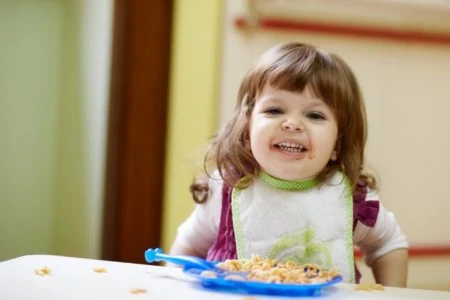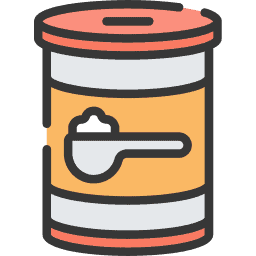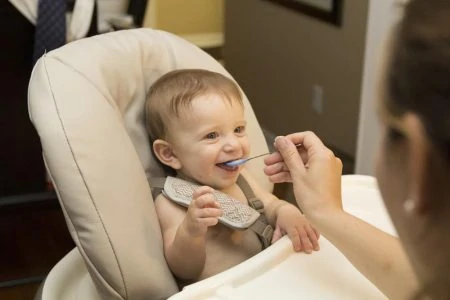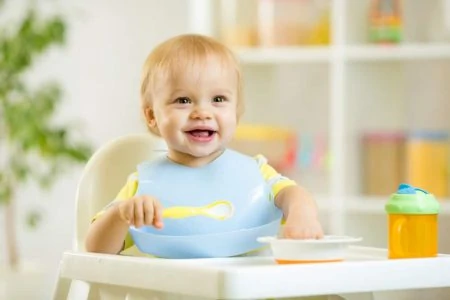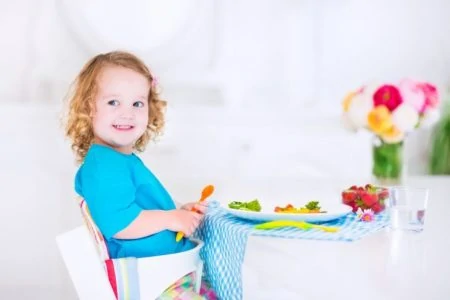Any parent with a self-feeding child knows how ridiculously messy mealtimes can get. Sometimes when you take the child out of their high chair after a meal, you’ll find more food beneath them than in their belly.
If you don’t clean your child’s high chair regularly, you can end up with caked-on crud and stained, grimy straps. I have a friend whose high chair got so disgusting that she took it to the car wash and used the industrial power sprayer to blast it clean.
Thankfully, it doesn’t have to come to that. A little daily maintenance, coupled with a regular deep clean, can keep your child’s high chair clean and sanitary.
We’ve done this so many times that we’ve mastered the process, and we’re sharing the steps with you here. Soon your high chair will be so clean, you can eat off it.
Key Takeaways
- Parents of self-feeding children know how messy mealtimes can be, and if not cleaned regularly, high chairs can harbor dangerous bacteria, which can be harmful to your child’s health.
- A study found that restaurant high chairs that are not deep cleaned regularly, harbor more germs than public toilet seats
- To keep your child’s high chair clean, it’s important to clean it regularly. Tasks that should be done daily include brushing off loose crumbs, wiping down the high chair to remove food particles, and sanitizing the tray/eating surface.
- Weekly cleaning tasks include removing the chair and cleaning the seat below, and cleaning the entire seat with a cleaning solution
- Monthly (deep clean) cleaning tasks include disassembling the high chair, cleaning the cushions and straps, removing food from small crevices, and eliminating stuck-on food.
- It is important to assess the material and construction of your baby’s high chair to determine the best way to clean it properly.
Can’t I Just Wipe It Down?
Watching your little one feed themself can be one of the most comical, rewarding, and cringeworthy activities you’ll engage in as a parent. It’s fun to watch them work so hard to learn an independent skill, but the resulting mess has no comparison.
If you’re not careful to regularly clean up all the spilled, smashed, and ground-in food from your child’s high chair, you may be exposing kids to dangerous bacteria. A study of restaurant high chairs (which are not deep-cleaned regularly) found that they harbored more germs than a public toilet seat (1).
Take Note
Additionally, it’s quite common for accidents to happen and high chairs to be exposed to your child’s fecal matter, urine, or vomit. When that happens, a simple wipe-down won’t suffice. You need to make sure you kill all the lurking bacteria.
Cleaning Different High Chair Materials
High chairs come in different shapes (such as hook on high chairs), sizes, and materials. Some are standalone units, while space-saving high chairs strap to regular chairs. Some are entirely plastic, while others have cushioned inserts.
Most high chairs are made of plastic, though some may contain metal parts — particularly in the mechanisms that detach the tray from the seat. If you have an antique high chair, it may be made of solid wood.
It’s important to assess the material and construction of your baby’s high chair to determine the best way to clean it properly.
Avoid soaking parts of your high chair if:
- It is made of wood.
- The cushion is made of fabric.
- It has metal parts.
Do not use bleach if:
- Your high chair is made of wood.
- The cushion is made of fabric.
How Often Do You Need To Clean High Chairs?
While you don’t have to spend hours every day cleaning your child’s high chair, there are some tasks you should do daily (or, even better, after every feeding session), while others can be done less frequently. One of the benefits of daily cleaning is that it prevents dirt build-up, making your deep-cleaning sessions easier.
Daily cleaning tasks include:
- Brushing off loose crumbs.
- Wiping down the high chair to remove food particles.
- Sanitizing the tray/eating surface.
Weekly cleaning tasks include:
- Removing the chair and cleaning the seat below (if it’s a space-saving model).
- Cleaning the entire seat with a cleaning solution.
Monthly (deep clean) cleaning tasks include:
- Disassembling the high chair.
- Cleaning the cushions and straps.
- Removing food from small crevices.
- Eliminating stuck-on food.
How To Clean High Chairs
1. Brush Off All Loose Crumbs (Every Use)
To prevent food from being ground into the cushion and safety belt, remove all loose crumbs after every feeding. Either gather them in a napkin or dishcloth to dispose of in the garbage or brush them to the floor and follow up with a quick sweep or vacuum.
2. Wipe Down With a Damp Cloth (Every Use)
After you’ve removed all large and loose food pieces, wipe the high chair down with a damp cloth using only water. Wipe all spaces where food can be trapped. Doing this immediately after eating prevents food from drying out and becoming a stubborn, stuck-on mess.
Make sure you wipe down all of the following parts to prevent food particle build-up:
- Seat.
- Cushion.
- Behind the cushion (if it’s loose-fitting).
- In the cushion crevices.
- Underneath the tray.
- Sides of the high chair.
- The release button.
3. Disinfect The Eating Surface (Every Use)
It’s important to keep the tray or eating surface sanitized since that is what’s in contact with your child’s food. Sanitize the eating surface by doing one of the following:
- Spray with white vinegar; allow to sit for five minutes and then wipe with a damp cloth.
- Spray with hydrogen peroxide; allow to sit for five minutes and then wipe with a damp cloth.
- Spray or wipe with a diluted bleach solution (two teaspoons of bleach to one gallon of water); allow to air dry.
- Wipe with a disinfectant wipe — widely available in retail stores.
Caution
4. Wipe The Seat Below The High Chair (Weekly)
If you have a space-saving high chair, remove it once a week and wipe down the chair below it with a damp cloth. It’s amazing how many food particles find their way underneath the high chair.
5. Clean The Exterior, Legs, and Underside (Weekly)
Also weekly, clean and disinfect the high chair parts that only get wiped down during the week. Use the disinfecting recommendations from Step 3. If stuck-on food is difficult to remove, use the scrubber side of a sponge or a Magic Eraser to remove it.
6. Remove and Wash Cushions and Straps (Monthly)
Once a month, deep clean your high chair. Remove the cushion and safety straps. Check the labels on the back of the high chair to confirm, but most can simply be thrown in the washing machine. If you choose this method, allow the straps to air dry; do not put them in the dryer.
If your accessories cannot go in the washer, wipe down the plastic cushion and soak the straps in a tub of soapy dish detergent to remove the grime. After soaking, scrub the straps and rinse them in warm water. Allow them to air dry.
7. Remove Crumbs from Crevices (Monthly)
Also monthly, work to remove caked-on food from the nooks and crannies of your high chair — in the same way you would detail your car.
The most common places food will get stuck are:
- Where the strap comes up through the seat.
- The release button.
- The clamping mechanism or other moving parts.
- Seams of the plastic.
Remove the food by using small tools, such as:
- A toothbrush.
- Dental floss.
- A toothpick.
8. Eliminate Stuck-On Food (As Needed)
If you have stubborn spots of dried food, you may need to use a little elbow grease and one of the following methods:
- Spray your high chair liberally with a solution of half water and half vinegar until very wet. Allow it to sit for 5–10 minutes to soften food particles. Scrub the stubborn food spots, and wipe the whole high chair down with a damp cloth.
- Soak the pieces in a tub of soapy dishwater to soften the food particles for easier removal. If you don’t have a sink or container large enough to hold your high chair, use a bathtub.
- Spray your high chair down with the hose outside.
FAQs
Easy Peasy!
Despite the regular messes our babies and toddlers make at mealtimes, cleaning your child’s high chair doesn’t have to be such a complicated process. Regular wipe-downs, weekly cleaning maintenance, and monthly deep-cleans will keep gross food build-up at bay and result in a healthier eating environment and happier mama!

